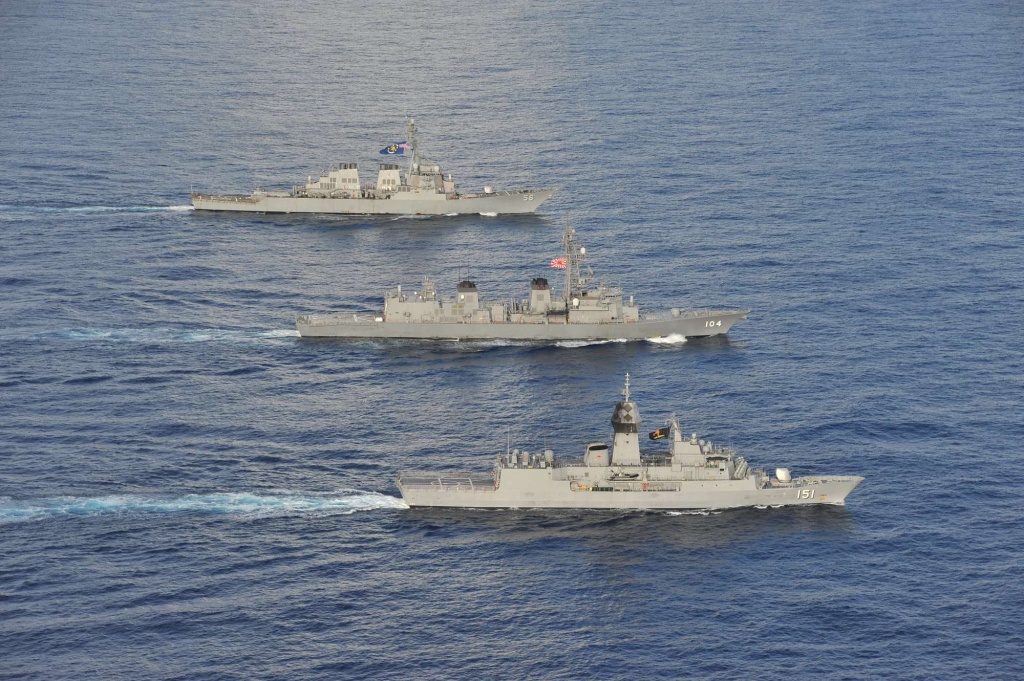2024年6月7日

Image: U.S. Pacific Fleet, 201020-N-NO824-0097. SOUTH CHINA SEA (Oct. 20, 2020) The Arleigh Burke-class guided-missile destroyer USS John S. McCain (DDG 56), rear, Japan Maritime Self-Defense Force (JMSDF) destroyer JS Kirisame (DD 104), middle, and Royal Australian Navy frigate HMAS Arunta (FFH 151) sail together in the South China Sea during multinational exercises. These exercises marked the fifth time of 2020 that Australia, Japan, and the U.S. have conducted operations together in the 7th Fleet area of operations. (Courtesy photo)
East Asia’s Alliance Dilemma:
Public Perceptions of the Competing Risks of Extended Nuclear Deterrence
Lauren Sukin and Woohyeok Seo
June 7, 2024
This report is published under a 4.0 International Creative Commons License the terms of which are found here.
This report is simultaneously published by the Asia-Pacific Leadership Network, Nautilus Institute, and the Research Center for Nuclear Weapons Abolition, Nagasaki University (RECNA).
It was first published in the Journal for Peace and Nuclear Disarmament.
This report is simultaneously published by the Asia-Pacific Leadership Network, Nautilus Institute, and the Research Center for Nuclear Weapons Abolition, Nagasaki University (RECNA).
It was first published in the Journal for Peace and Nuclear Disarmament.
Abstract
Against the backdrop of a rapidly changing security environment in East Asia, regional actors have seen a surge in “nuclear anxiety.” Worries among citizens of US allies and partners about rising nuclear threats and nuclear proliferation risks critically shape US foreign policy in East Asia. This paper thus asks: What drives nuclear anxiety in East Asia? And how can the United States most effectively resolve it? We situate nuclear anxiety in the dynamics of abandonment and entrapment that exist between allied states, as well as in the unique regional security structure, or the hub-and-spoke system in East Asia. To better understand the implications of nuclear anxiety on regional nuclear policy, we analyze the results of an original survey conducted in June 2023 across Washington’s five allies and partners in East Asia: Australia, Indonesia, Japan, South Korea, and Taiwan. The survey results suggest the presence of the dynamics of both nuclear entrapment and abandonment among these regional actors, as well as mixed interests in indigenous nuclear programs. In addition, we demonstrate how citizens of East Asia evaluate possible policy options that could help Washington mitigate regional nuclear anxiety.
Keywords: nuclear; alliances; East Asia; proliferation; security
Authors’ Profile:
Lauren Sukin is an Assistant Professor of International Relations at the London School of Economics and Political Science in the United Kingdom.
Woohyeok Seo is a Ph.D. Candidate in International Relations at the London School of Economics and Political Science in the United Kingdom.
Woohyeok Seo is a Ph.D. Candidate in International Relations at the London School of Economics and Political Science in the United Kingdom.
Full text (PDF) is here.
The views represented herein are the author’s own and do not necessarily reflect the institutional positions.
The page for this project is here.

















